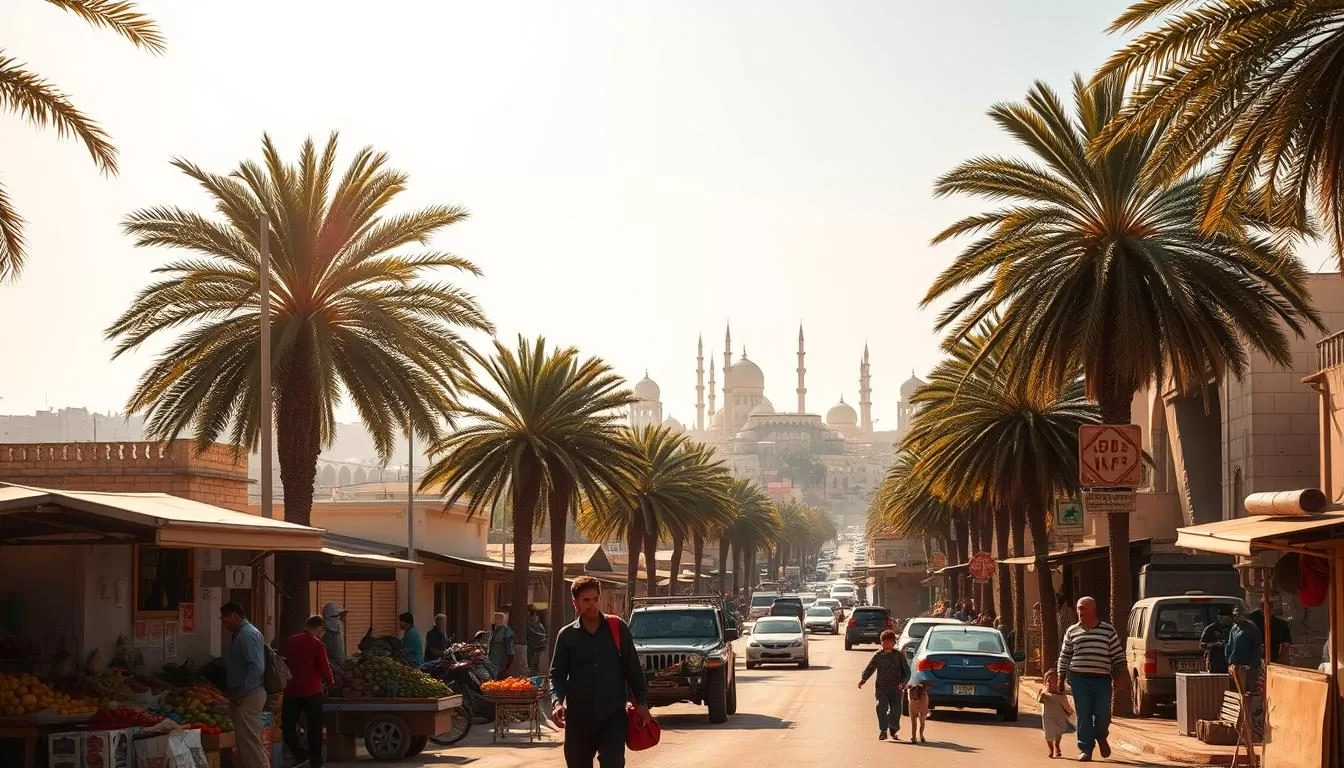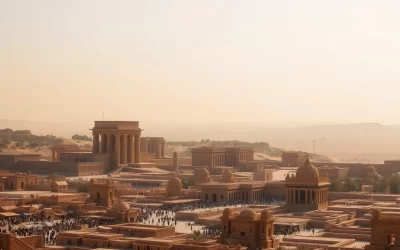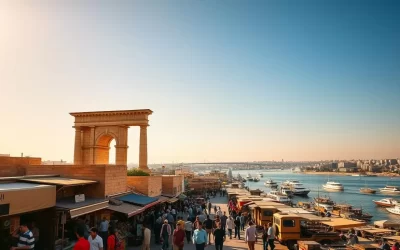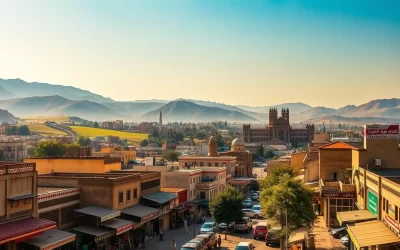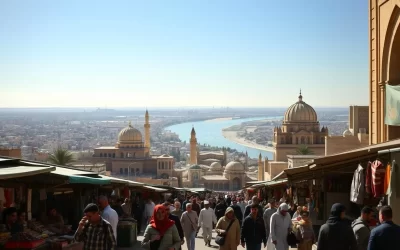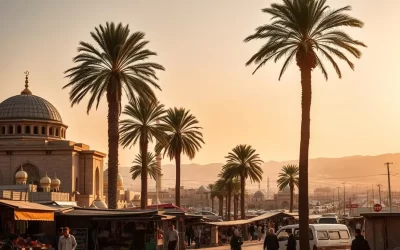Planning your next adventure? Understanding the weather and temperature trends can make all the difference. This guide will help you pick the perfect time to explore this historic place, ensuring your trip is as enjoyable as possible.
Summers here are known for their intense heat, with daily highs often reaching up to 112°F. Winters, on the other hand, offer cooler conditions, with lows around 41°F. These distinct seasons mean your experience can vary greatly depending on when you choose to visit.
Rainfall and daylight hours also play a key role in planning your day. By aligning your travel with optimal conditions, you can make the most of your time and enjoy everything this vibrant destination has to offer.
Understanding Baghdad’s Climate Patterns
Understanding the climate of your destination is key to a smooth travel experience. The weather here varies dramatically throughout the year, with distinct seasonal patterns that can influence your plans. Let’s break down the key factors to help you decide the best time to visit.
Temperature Trends Throughout the Year
Daily temperature changes are significant, especially during the summer and winter months. In July, average highs can reach up to 109°F, making it the hottest time of the year. On the other hand, January sees lows around 37°F, offering a much cooler experience. These extremes mean your day can feel very different depending on the season.
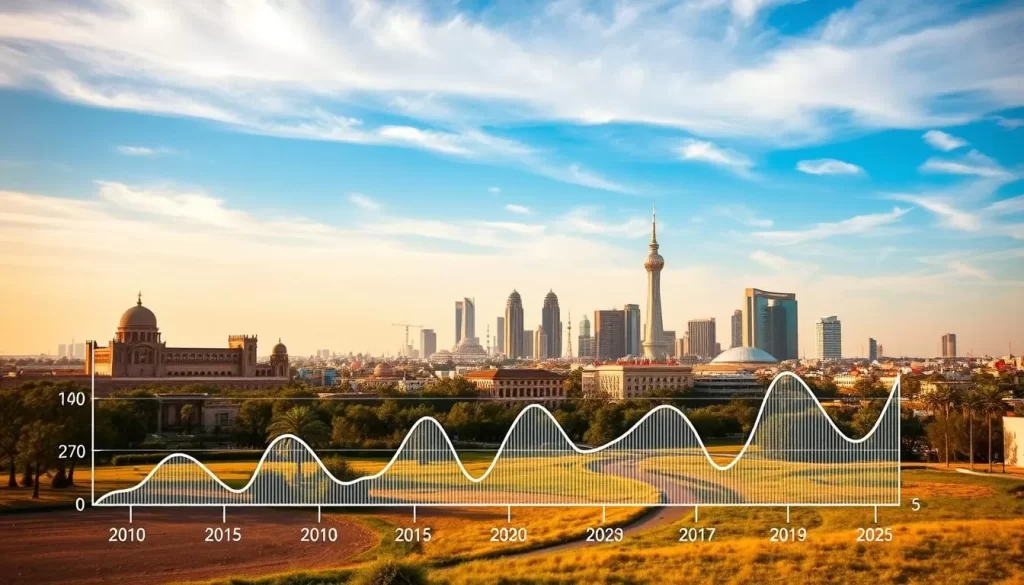
During the winter, nighttime temperatures can drop by over 36°F compared to daytime highs. This sharp variation makes layering essential for comfort. In contrast, summer nights remain warm, with minimal cooling after sunset.
Precipitation and Cloud Cover Insights
Rainfall is another important factor to consider. The wet season runs from November to April, with December being the wettest month. During this time, occasional rain can add a refreshing touch to your day. However, the summer months are almost entirely dry, with nearly zero rain days.
Cloud cover also changes throughout the year. Winters often bring more clouds, which can make the weather condition feel milder. Summers, on the other hand, are mostly clear, contributing to the intense heat. Understanding these patterns can help you pack appropriately and plan your activities.
Key Weather Statistics and Data Insights
Timing your visit right can make all the difference in your travel experience. Understanding sunrise, sunset, and daylight variations is essential for planning your day. These factors not only influence your activities but also help you make the most of your time outdoors.
Sunrise, Sunset, and Daylight Variations
Daylight hours vary significantly throughout the year. On December 21, the shortest day, you’ll experience around 10 hours of daylight. In contrast, June 21 offers the longest day, with nearly 14 hours of sunlight. These changes can impact your sightseeing plans and outdoor activities.
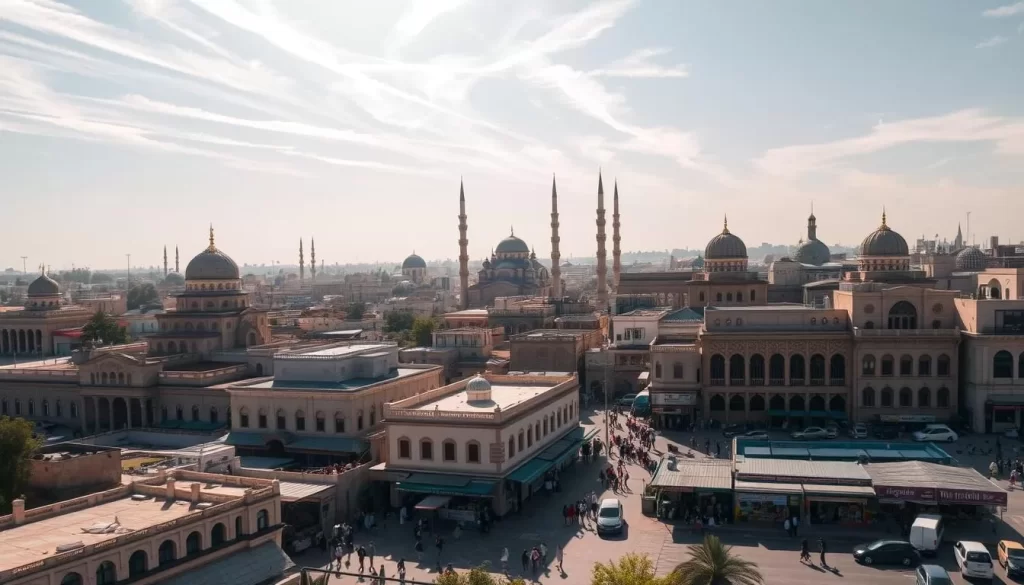
During the summer solstice, the extended daylight allows for more exploration time. However, the intense temperature during these months may limit outdoor activities to early mornings or late evenings. Winter, with shorter days, offers cooler conditions but requires efficient planning to maximize daylight hours.
Rainfall is another factor to consider. While the wet season brings occasional rain, it rarely disrupts travel plans. Combining this datum with temperature and daylight trends ensures a well-rounded itinerary.
By analyzing these statistics, you can decide the best time to visit historic areas. Early mornings or late afternoons are ideal for avoiding peak temperature and enjoying comfortable sightseeing conditions.
Baghdad, Iraq: Best Months for a Weather-Savvy Trip
Choosing the right time to explore a destination can elevate your travel experience. When planning your visit, understanding seasonal patterns is key to enjoying comfortable weather and making the most of your day.
Peak Weather Scores and Seasonal Insights
Optimal travel periods are determined by evaluating temperature, rainfall, and sky clarity. These factors combine to create peak weather scores, which highlight the best time to visit. Mild temperatures and minimal precipitation are the hallmarks of ideal travel conditions.
Early March to late April and mid-October to mid-November are consistently rated as the best months to visit. During these periods, the temperature ranges from 15°C to 25°C, offering a pleasant climate for outdoor activities. Rainfall is minimal, and the skies are mostly clear, ensuring uninterrupted sightseeing.
Here’s why these months stand out:
- Mild temperatures make it comfortable to explore historic sites and outdoor attractions.
- Low rainfall reduces the chances of disruptions to your plans.
- Clear skies provide excellent visibility for photography and sightseeing.
Seasonal transitions, such as the shift from summer heat to autumn coolness, create a balanced condition for travel. These insights, backed by accumulated datum, ensure you can plan your trip with confidence.
By aligning your visit with these optimal periods, you’ll enjoy a seamless and enjoyable experience. Whether you’re exploring cultural landmarks or relaxing outdoors, the right time makes all the difference.
Planning Your Itinerary Around Optimal Weather
Crafting a travel plan that aligns with optimal weather conditions ensures a memorable experience. By understanding seasonal travel scores, you can structure your itinerary to make the most of your time and enjoy every day to the fullest.

Seasonal Travel Scores and Recommendations
Seasonal travel scores are based on temperature, rainfall, and sky clarity. These scores highlight the best time to visit, ensuring you experience comfortable weather conditions and minimal disruptions.
For outdoor activities, focus on months with mild temperatures and clear skies. Early spring and late autumn are ideal, offering pleasant climates for sightseeing and exploration.
Here’s how to plan your day trips:
- Schedule outdoor activities during early mornings or late afternoons to avoid peak heat.
- Choose periods with maximum daylight to extend your sightseeing time.
- Check weather forecasts to ensure minimal rain during your planned activities.
Combining travel scores with temperature datum helps create a balanced itinerary. This approach ensures you enjoy every moment without worrying about unexpected weather changes.
By aligning your plans with these insights, you’ll have a smoother and more enjoyable travel experience. Whether you’re exploring historic sites or relaxing outdoors, the right time makes all the difference.
How Weather Influences Outdoor Activities
Weather plays a crucial role in shaping your outdoor experiences. Whether you’re planning a relaxing day by the pool or exploring historic sites, understanding how temperature, wind, and rain affect your plans is essential. Let’s dive into how these factors influence your activities and how you can make the most of your time outdoors.

Insights on Tourism and Beach/Pool Scores
When planning outdoor activities, beach and pool scores are a great way to gauge the best time to visit. These scores consider temperature, wind, and sky clarity to determine ideal conditions. For example, late April to late May and mid-September to mid-October are perfect for pool or beach outings.
Here’s a breakdown of the factors that influence these scores:
| Factor | Impact |
|---|---|
| Temperature | Mild temperatures (15°C-25°C) ensure comfort for outdoor activities. |
| Wind | Gentle breezes make sunny days more enjoyable without being overpowering. |
| Rain | Minimal rainfall reduces disruptions to your plans. |
Suggestions for Weather-Dependent Activities
Choosing activities that align with the forecast ensures both fun and comfort. For example, on a sunny day in June, temperatures can peak, making early mornings or late afternoons ideal for sightseeing. Here are some recommendations:
- Visit historic sites during cooler parts of the day to avoid midday heat.
- Plan pool or beach activities during months with high beach/pool scores.
- Check weather forecasts to avoid unexpected rain or wind.
By aligning your plans with these insights, you’ll enjoy a seamless and enjoyable experience. For more tips on planning your trip, check out this detailed guide.
Navigating Unsuitable Weather Periods
Exploring a new destination requires careful planning, especially when it comes to weather. Extreme temperature swings can make certain times of the year less ideal for outdoor activities. By understanding these challenges, you can prepare effectively and still enjoy your day.
Dealing with Extreme Temperature Swings
During the summer months, temperatures can soar above 40°C (104°F), making outdoor exploration uncomfortable. On the shortest day of the year, December 21, daylight is limited to around 10 hours, and winter lows can drop to 4°C (39°F). These extremes require thoughtful planning to ensure comfort.
Here are some strategies to manage harsh conditions:
- Stay hydrated and wear lightweight clothing during summer heat.
- Layer up during winter to handle sudden temperature drops.
- Plan outdoor activities for early mornings or late afternoons to avoid peak heat or cold.
For example, during day June, temperatures peak in the afternoon, making mornings the best time for sightseeing. On day December, shorter daylight hours mean efficient scheduling is key to maximizing your day.
“Smart planning can turn even the most challenging weather into an opportunity for unique experiences.”
Alternative Activities During Unsuitable Weather
When outdoor conditions are less than ideal, consider indoor alternatives. Museums, historical sites, and cultural centers offer enriching experiences without exposing you to extreme weather conditions. For instance, exploring the rich history of higher education in the region can be both educational and inspiring. Learn more about the impact of political turmoil on education in this detailed study.
Here’s a quick guide to managing unsuitable weather:
| Weather Condition | Recommended Activity |
|---|---|
| Extreme Heat | Visit air-conditioned museums or cultural centers. |
| Cold Winter Days | Explore indoor historical sites or local markets. |
| Sandstorms | Stay indoors and enjoy local cuisine or traditional performances. |
By aligning your plans with these insights, you can make the most of your day, even during challenging weather. For more tips on navigating extreme conditions, check out this comprehensive guide.
Gearing Up: Essential Travel Tips for Baghdad
Packing smartly can make or break your travel experience, especially when dealing with unpredictable weather. The temperature here can swing dramatically, so preparing for both heat and cold is essential. By following these guidelines, you’ll stay comfortable and ready for anything during your time visit.
Packing Guidelines for Varied Weather Conditions
When packing for your trip, consider the datum on seasonal weather patterns. Summers can be scorching, with highs reaching 112°F, while winters can drop to 41°F. Layering is your best friend—lightweight, breathable fabrics for the day and warmer layers for cooler evenings.
Here’s a quick checklist to help you pack smartly:
- Clothing: Pack a mix of short and long-sleeved tops, lightweight pants, and a jacket for cooler nights.
- Sun Protection: Bring a wide-brimmed hat, sunglasses, and high-SPF sunscreen to shield yourself from intense sun exposure.
- Rain Gear: While rain is rare in summer, winter months can bring occasional showers. A compact umbrella or rain jacket is a wise addition.
Sudden weather changes are common, so always be prepared. For example, a sunny day can quickly turn chilly in the evening, especially during winter. Packing versatile items ensures you’re ready for any scenario.
“The right preparation turns unpredictable weather into an opportunity for adventure.”
By aligning your packing with these tips, you’ll maximize your comfort and enjoy every day of your trip. For more detailed travel tips for visiting Baghdad, check out this comprehensive guide.
Considerations Beyond the Weather
While weather is a key factor in planning your trip, other considerations like safety and cultural experiences are equally important. To make the most of your day, it’s essential to balance weather expectations with awareness of local conditions and attractions.
Traveler Safety and Local Precautions
Your safety is a top priority when visiting any new place. Due to ongoing security concerns, it’s crucial to stay informed and take necessary precautions. Always check travel advisories and follow local guidelines to ensure a smooth experience.
Here are some practical tips to enhance your safety:
- Stay in well-reviewed accommodations and avoid unfamiliar areas after dark.
- Keep important documents secure and have emergency contacts readily available.
- Be mindful of local customs and dress modestly to respect cultural norms.
By staying vigilant and prepared, you can focus on enjoying your day without unnecessary worries.
Cultural and Historical Attractions
This historic place is home to a wealth of cultural and historical sites that shouldn’t be missed. From ancient landmarks to vibrant markets, there’s something for every traveler to explore.
Here are a few must-visit attractions:
- The National Museum of Iraq, which showcases artifacts from Mesopotamia and beyond.
- Al-Mustansiriya School, a stunning example of Islamic architecture.
- Al-Shaheed Monument, a poignant tribute to Iraqi history and resilience.
These sites offer a glimpse into the rich heritage of the region, making them ideal for any day trip. For more insights into the historical significance of these landmarks, check out this detailed analysis.
Careful planning and awareness of the local context can enhance your overall enjoyment. By combining weather insights with safety measures and cultural exploration, you’ll create a memorable and fulfilling experience. For additional tips on navigating unique challenges, refer to this comprehensive guide.
Conclusion
Making informed decisions about your travel plans ensures a seamless and enjoyable experience. By understanding the temperature trends and seasonal patterns, you can choose the best time to explore this historic place. Planning your trip around optimal weather conditions allows you to make the most of every day.
Aligning your visit with mild temperatures and minimal rainfall ensures uninterrupted sightseeing and outdoor activities. Early spring and late autumn are ideal for comfortable exploration, offering clear skies and pleasant climates.
For more insights on economic reforms and their impact on travel, check out this detailed report. With careful planning, you can enjoy a memorable and enriching journey, making every day count.
The above is subject to change.
Check back often to TRAVEL.COM for the latest travel tips and deals.
